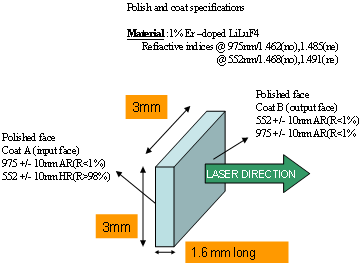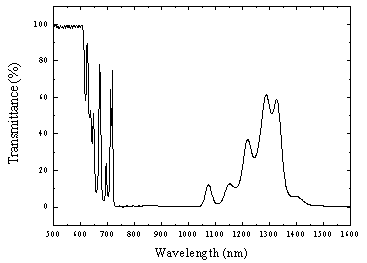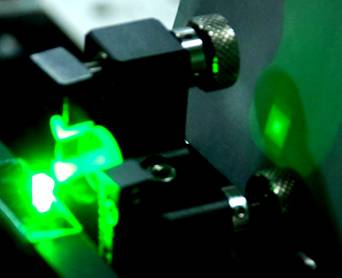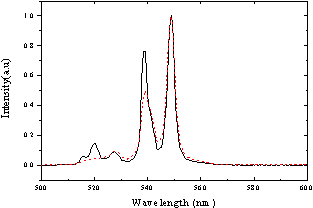-
Paper Information
- Next Paper
- Previous Paper
- Paper Submission
-
Journal Information
- About This Journal
- Editorial Board
- Current Issue
- Archive
- Author Guidelines
- Contact Us
International Journal of Optics and Applications
p-ISSN: 2168-5053 e-ISSN: 2168-5061
2012; 2(5): 72-75
doi: 10.5923/j.optics.20120205.03
A Green Upconversion Laser with Erbium-Doped LiLuF4 Crystal by 976 nm Fiber Laser Pump
Hong-Xi Tsao 1, 2, Shih-Ting Lin 2, Chih-Lin Wang 2, Hsin-Chia Su 2, Chien-Ming Huang 2, Yao-Wun Jhang 2, Chieh Hu 2, Tzong-Yow Tsai 1, Jinn-Kong Sheu 1
1Department of Photonics, National Cheng Kung University, Tainan, 70101, Taiwan
2Industrial Technology Research Institute, No.8, Gongyan Rd., Liujia Dist., Tainan City, 73445, Taiwan
Correspondence to: Jinn-Kong Sheu , Department of Photonics, National Cheng Kung University, Tainan, 70101, Taiwan.
| Email: |  |
Copyright © 2012 Scientific & Academic Publishing. All Rights Reserved.
A stable fiber laser operating at approximately 976 nm peak power at a 280 ns and 1.9 W pump was used as a pumping source for an upconversion laser based on an Er 3+ :doped LiLuF4 crystal. A 548 nm wavelength and 320 mW could be achieved. In this study, we used a 976 nm low threshold average pump power fiber laser at 8 mW, which can achieve green upconversion laser output at room temperature. This system includes a high reflective coating at 552 nm+/-10 nm on the LiLuF4 crystal and a 96% reflective mirror forming a laser cavity for the 548 nm laser. Using the laser cavity setup and 976 nm fiber laser pump, low threshold pump power green erbium upconversion lasing was achieved. The two peak wavelengths of 548 nm and 537 nm are observed and the intensity changes by changing the input to 976 nm pump power.
Keywords: Erbium-Doped, Green Upconversion, LiLuF4 Crystal
Cite this paper: Hong-Xi Tsao , Shih-Ting Lin , Chih-Lin Wang , Hsin-Chia Su , Chien-Ming Huang , Yao-Wun Jhang , Chieh Hu , Tzong-Yow Tsai , Jinn-Kong Sheu , "A Green Upconversion Laser with Erbium-Doped LiLuF4 Crystal by 976 nm Fiber Laser Pump", International Journal of Optics and Applications, Vol. 2 No. 5, 2012, pp. 72-75. doi: 10.5923/j.optics.20120205.03.
1. Introduction
- Upconversion lasers are particularly attractive because of their wide lasing wavelength range from infrared to ultraviolent[1,2] and are used in various applications, such as medical diagnosis, medical treatment, industrial machining, and full-color all-solid-state displays[3,4]. Compared with semiconductor diode lasers, with which lasing in the green wavelength region at room temperature is difficult[5], upconversion lasers are reported to enable lasing in the green wavelength region with different hosts of low phonon energy, including LiLuF4, LiYF4, BaY2 F8, and ZBLAN (ZrF4–BaF2–LaF3–AlF3–NaF)[6,7]. These low phonon-energy hosts are popular in upconversion lasers because of their lower nonradiative relaxation rates and their longer lifetimes in more highly excited states. Lower nonradiative relaxation rates and longer lifetimes in highly excited states are critical in enabling a laser to overcome population inversion. This study focuses on an upconversion laser system composed of near-infrared light sources and rare-earth-doped crystals[7]. This upconversion is a non-linear process that involves two or more low-energy excitation photons being converted into one or two high-energy photons. Particularly, erbium (Er3+)-doped materials are more suitable for the upconversion processes because of the unique energy level structure of Er3+. By absorbing the radiation of near-infrared light, visible radiation emits from rare-earth-doped crystals. Fig. 1 shows the upconversion process. In Er3+:LiLuF4, for example, when pumped by a 976 nm light source, the trivalent erbium ion with multiplet 4I3/2 is excited by two sequential steps. The first step is ground-state absorption from 4I15/2 to 4I11/2. The second step is an excited state from 4I11/2 to 4F7/2. The 4I11/2 is the so-called intermediate level. The excited photon relaxes to 4S3/2 then decays to a ground state with emitting visible radiation at 548 nm[8-10].
 | Figure 1. Energy level scheme of Er3+:LiLuF4 with 976nm pump laser |
2. Experimental Setup
- As mentioned previously, lower nonradiative relaxation rates and longer lifetimes in highly excited states are critical in enabling a laser to overcome population inversion. In this study, we selected specifications of LiLuF4 crystal has expected small phonon energy because the mass of Lu3+ ion is high, and the high lifetime of meta stable state, as shown in Fig. 2. The face of the LiLuF4 crystal was prepared by using a coated mirror, which is a high transmitter of the pump wavelength (976 nm) and a high reflector of the laser wavelength (548 nm), as shown in Fig. 3.
 | Figure 2. Polish and coating specifications of LiLuF4 crystal |
 | Figure 3. High reflective coating range to 548 nm on LiLuF4 crystal |
 | Figure 4. Experimental setup for up conversion |
 | Figure 5. Mirror 1 appeared low transmittance to 548 nm laser and formed a 548 nm laser cavity with the coating on the face of LiLuF4 crystal |
 | Figure 6. Mirror 2 of low transmittance to 976 nm and 1550 nm provided a 548 nm single wavelength output |
3. Results and Discussion
- In the laser experiment, a visible upconversion laser was used, as shown in Fig. 4. The peak wavelength was 548 nm and a spectral width of approximately 4 nm at low-threshold average pump power 25 mW and efficiency is 17 %. At 1.9 W input laser peak power, the maximum output laser peak power was 320 mW with a similar efficiency of 17 %, as shown in Figs. 7-9. The green upconversion laser is shown in Fig. 10. The spectrum peak wavelengths were 548 nm and the peak of 537 nm has a different intensity, as shown in Fig. 7.
 | Figure 7. Maxium peak wavelength of output laser is 548 nm |
 | Figure 8. Efficiency of upconversion system |
 | Figure 9. Input peak power at 1.9W can get max output power 320mW |
 | Figure 10. Visible upconversion laser by experiment setup in Figure7 is achieved |
 | Figure 11. Fluorescence spectrum of the Erbium-Doped LiLuF4 Crystal |
4. Summary
- In conclusion, we demonstrated a pulsed fiber laser pumping visible 548 nm upconversion laser system. The Er3+:LiLuF4 crystal, green emission amplification can be achieved by using a 976 nm, 280 ns pulse-pump laser and by using a mirror coating to suppress the 1550 nm laser emission. When the pumping power is lower than the laser threshold, the emission spectrum has two obvious peaks at 537 nm and 548 nm. After increasing the pumping power over the amplified threshold, the peak of 537 nm reduces and lases at 548 nm. The spectral width of 548 nm lases at approximately 4 nm. By using 8 mW input pump power, the maximum output laser peak power was 320 mW. The average efficiency of upconversion is approximately 17%.
 Abstract
Abstract Reference
Reference Full-Text PDF
Full-Text PDF Full-Text HTML
Full-Text HTML